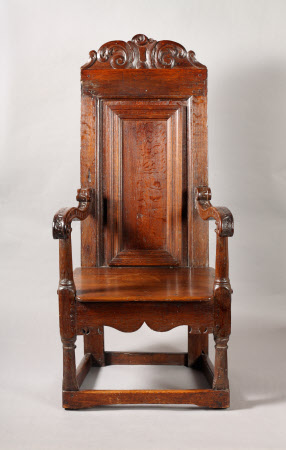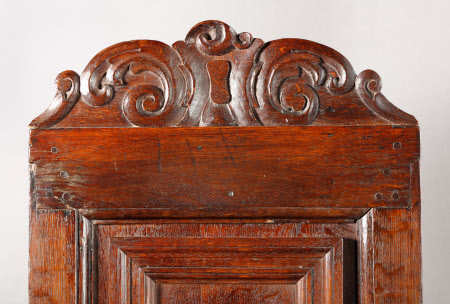Panel-back armchair
Category
Furniture
Date
circa 1570
Materials
Joined, turned and carved oak
Measurements
130 x 60 x 44.5 cm
Place of origin
Westmorland (England)
Order this imageCollection
Sizergh Castle, Cumbria
NT 997990
Summary
A panel-back open armchair, English, probably Westmorland, circa 1570, with replaced toprail and later arms. The foliate scroll-carved and arched cresting to this chair is probably 16th century, but has either been repaired (its ends are truncated, and there are an unorthodox number of large pegs fixing it to an unusual position on the toprail) or it is a replacement, suggested by its awkward joint with the toprail. The downswept carved arms are later, probably 17th century, and the marks where the original arms joined the rear uprights can clearly be seen above the site of the present arms. The boarded seat is also probably a replacement.
Full description
A panel-back open armchair, English, probably Westmorland, circa 1570, with replaced toprail and later arms. The foliate scroll-carved and arched cresting to this chair is probably 16th century, but has either been repaired (its ends are truncated, and there are an unorthodox number of large pegs fixing it to an unusual position on the toprail) or it is a replacement, suggested by its awkward joint with the toprail. The downswept carved arms are later, probably 17th century, and the marks where the original arms joined the rear uprights can clearly be seen above the site of the present arms. The boarded seat is also probably a replacement. However, despite these alterations, this chair is clearly part of the group of seat furniture at Sizergh which includes NT 997985 (dated 1571), the pair of chairs NT 997986.1 & .2 (dated 1570) and NT 997991 which is Elizabethan but undated. Stylistic similarities, such as the mouldings applied to the back panel, the turnings and the shaped seat rails, shared by this chair and the dated examples strongly suggest that this example and NT 997991 were made at the same time, circa 1570. This back panel is applied with mouldings to form a large rectangle. It was possibly made, therefore, to sit in either the now-called Dining Room (in 1569 this was Walter Strickland's 'Great Chamber') whose overmantel is dated 1564, or in the next-door Queen's Room (in 1569 this was Walter Strickland's 'Withdrawing Chamber') which contains an overmantel dated 1569, both of which have panels decorated with mouldings forming rectangles. The legs of this chair are columnar and with simple ring-turnings but are truncated, and now without feet. The stretchers are replaced. The turned front legs and plain rectangular-section rear legs relate this chair to NT 997985. Despite its alterations, this chair is a remarkable survival and was probably the best that money could buy in its day. The timber is choice, the mouldings sophisticated and the proportions imposing. The inventory of Sizergh taken on 27th April 1569 associated with Walter Strickland's will mentions various chairs; the one in the Lord's Chamber - the most expensive - was 3s 4d. A publication of 1908 by Daniel Scott transcribes another document, taken on 28th June 1569, which lists the contents of some rooms, but groups other pieces by category under titles such as 'Woddewarke'. 8 'newe chayres' were listed, as were one 'ney [new?] lytle chayres for a woman or chyld' and two 'old chayres off lynd' [lime?].
Provenance
Probably commissioned by Walter Strickland (1516 - 1569) and his wife Alice (d. 1588). Photographed in the Banqueting Hall in Country Life in 1906. Thence by descent and given by Henry Hornyold Strickland (1890 – 1975) with Sizergh Castle and its estates in 1950.
Credit line
Megan Wheeler
References
Sizergh Castle, Country Life (June, 1906), Vol. XIX, No. 495., p. 944 Scott (1908), Daniel Scott, The Stricklands of Sizergh Castle, p. 109

